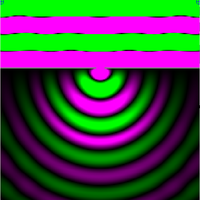Diffrazione del suono en
Da "Fisica, onde Musica": un sito web su fisica delle onde e del suono, acustica degli strumenti musicali, scale musicali, armonia e musica.
Jump to navigation Jump to searchWhat is diffraction?
When a wave encounters an obstacle in its path or passes a small opening, under certain physical conditions that we will investigate later, it manifests a peculiar behaviour: it (along with the energy it is transporting) can reach points that would not be reachable if propagation occurred following straight rays. It is as if the wave "breaks up" (hence the name of the phenomenon - from the Latin "diffractus", the past participle of de-frangere - which was coined for the first time by F. M. Grimaldi in 1665) and then recomposes while spreading beyond the obstacle or opening.
Sound diffraction
As sound is a wave, it is subject to the diffraction phenomenon in certain conditions. Those conditions are illustrated in general on the page about diffraction and can be summarised by saying that:
- a wave can pass through an opening without significantly modifying the shape of its wave fronts if the size of the opening is much greater than the wavelength of the wave. In cases where the opening is narrow (or much smaller than the wavelength), the wave front of the incident wave is deformed and becomes almost spherical. If you wish to see these effects, visit our 2D Wave virtual laboratory and try the experiment described on this page:
- a wave can "go around" an obstacle if the size of the obstacle is less than (or the same as) the wavelength of the incident wave. For this case as well, visit our 2D Wave virtual laboratory and try the experiments described on these pages:
On this page, we illustrate the specific phenomena of sound diffraction. Since the criterion for establishing the presence or absence of diffraction is related to wavelength, we invite you to read the page on sound wavelength. For sake of readability, here are the data reported there: sound has a wavelength from 1.7 cm (very high sounds at 20,000 Hz at the upper threshold of audibility) to 17 metres (very low sounds at 20 Hz at the lower threshold of audibility).
Sound directionality
When a sound is irradiated from a source (e.g. a loudspeaker), we immediately realise that it is much easier to localise the direction that the sound is coming from when it is a high pitch sound (high frequencies and short wavelengths) rather than a low pitch sound (low frequencies and long wavelengths). This is completely consistent with the first criterion previously illustrated: in this case, the source is the loudspeaker (instead of the opening). If you have tried the experiments, you will have seen these two situations:
Ability of sound to go around obstacles
When a sound encounters an obstacle, its ability to go around it depends on the ratio of the obstacle size to the sound wavelength, as established by the second general criterion previously stated. In the case of sound, we could say that, with the same obstacle size,
-
-
- lower sounds (of longer wavelength) can more easily go around obstacles
-
This fact has a series of important consequences:
- low sounds can go beyond an obstacle such as a person's head. This means that:
- as previously mentioned, if we receive a low sound, we might find it difficult to localise the source. That sound can go around our head and reach both our ears. Even if we estimate the delay time between the arrival at one ear and the other, our auditory system can get information regarding the localisation of a sound source.
- if we are standing behind a person and listening to them, it will be difficult for us to understand what they are saying. The fact is that only low-frequency waves can go around the head of the person speaking and reach our ears. This, as explained on the page about the voice, makes it difficult to recognise the formants of the vocal sounds.
- in any case, everyday obstacles (a tree, wall, column, etc.) are smaller than the majority of sounds used in speech and music. It is for this reason that sound goes beyond them so easily! This does not happen with light, which has much smaller wavelengths than the size of a tree; light is stopped and behind the tree a shadow is formed, under which we often seek refuge on a sunny day.
In-depth study and links
- A very helpful principle to understanding what happens to a wave when it encounters an obstacle or an opening, if only qualitatively, is that of Huygens. If you wish to learn more, visit this page.
- The phenomenon of sound diffraction plays a fundamentally important role in designing closed environments with "good acoustics". This topic is further discussed on the page about architectural acoustics.
- The phenomenon of sound diffraction is in some way complementary to that of sound reflection. If you wish to have a more complete picture of what happens when a sound wave encounters an obstacle, visit the page on sound reflection.
- On the page about musical instruments, and in particular the one dedicated to the trumpet, you can listen to an interesting recording done with a microphone placed in front of or behind a trombonist. The perceptible change in timbre of the instrument is due to the ability of various frequencies to go around the obstacle created by the trombonist's head.



